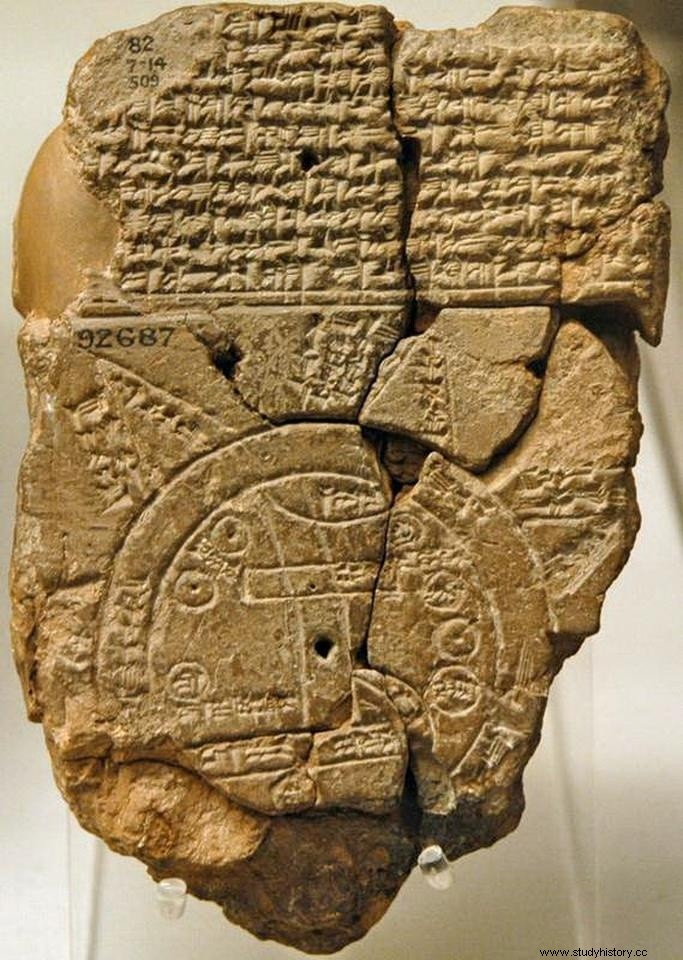There's an old female joke that says the reason millions of sperm are needed to fertilize an egg is because, being male, they don't read the blueprint or ask the way. Ironies aside, for as long as humanity exists it seems that human beings have tried to map the environment they knew or what they thought was the world they lived in. Some historians believe that the oldest plan is found on a wall at the Catal Huyuk site. (ancient Neolithic settlement south of the Anatolian peninsula, Turkey). This plan would represent a city (perhaps Catal Huyuk itself, although it does not seem to coincide with the site) with an erupting volcano near it.

Catal Huyuk
Later we find more examples of maps in ancient Mesopotamia. Apart from several tablets that have been discovered, representing cultivated fields with their dimensions, and some other collecting the irrigation canals of cities such as Umma or Babylon , one of the most interesting is preserved in the Hilprecht collection , from the Friedrich-Schiller University of Jena (Germany). It is an 21×18 cm specimen that represents the city of Nippur . The plan, drawn around 1500 BC, includes some measurements that, verified today on the site, are surprisingly precise. Some important temples appear, the great canals that crossed the city, as if it were a Sumerian Venice, and even its gates. Some of the gates have names related to their orientation, such as the Kagal Uruk , Gate of Uruk, or the Kagal Ur , Gate of Ur. Others indicate its magnificence, such as the Kagal Mah , Sublime Gate. And others have names that are curious to us, such as the Kagal Mushukhatim , Gate of the Sexually Impure, outside of which the ashes of those executed for horrendous crimes were scattered (see «The Eakildukku in Sumeria, a mixture between Guantánamo and the Green Mile«). In one part of the map we even find the representation of a large urban park crossed by canals and with exotic plants, something very modern.

Nippur
But more important than the plans are the maps of the world , because they offer us an idea of the image that a certain people had of the world. The oldest world map found so far, and preserved in the British Museum, was made in the 6th century BC. in the city of Babylon, based on another, possibly 200 years older, which has not been preserved. The central zone represents Babylon, Assyria, Uratu (Armenia) and Habban (Yemen). It also includes the mountains where the Euphrates rises and the double central circle represents the sea, named as «salty river «. The rest of the world appears in the form of seven star peaks that are named after islands, of which only three names are preserved:that of the «rising sun «, the one of the «hidden sun where darkness reigns » and the one «beyond the flight of birds «. A curious element is that Egypt does not appear, perhaps due to political quarrels.

And finally, and returning to the initial irony, we should ask ourselves:were these shots used, or not? There is a Sumerian proverb that says:
The groom does not ask the way; the groom does not ask the destination.
Who knows! Perhaps female humor is as old as the invention of maps, after all.
NOTE:the Mesopotamians, in case anyone is wondering, did not know the cardinal points as we do. They named them according to wind-directions. Its North corresponded with our Northwest. Thus, they had the Stormy Wind (Northwest); the Wind of the Amorites (Southwest); the Wind of the Mountains (Southeast) and the Wind of the Boat Against the Current (Northeast).
Contributed by Joshua BedwyR author of In a Dark Blue World
